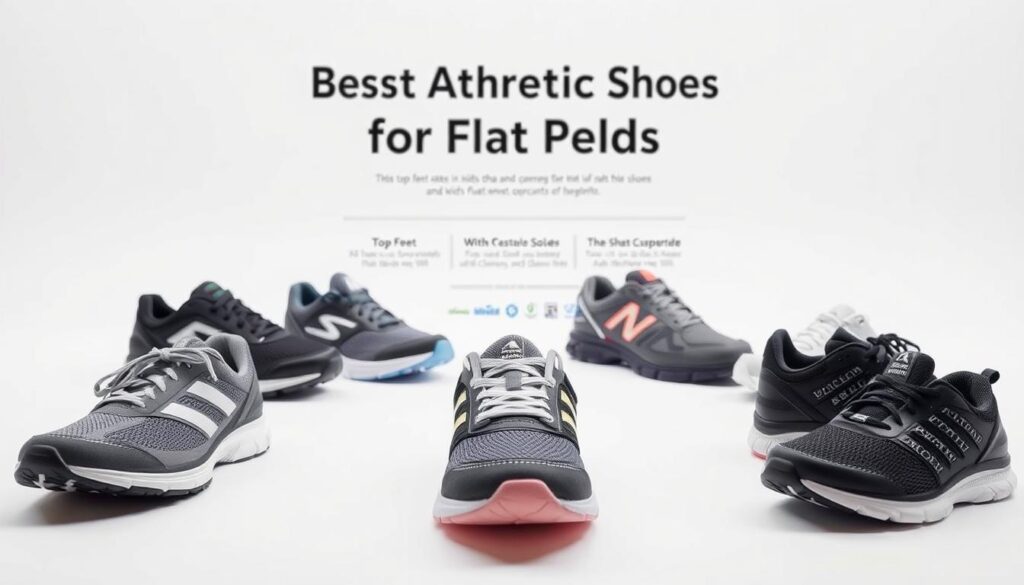Shoes For Flat Feet Kids? As a parent, you want the best for your child, especially their health and comfort. If your child has flat feet, finding the right shoes is key. The right shoes can help with pain and make daily activities easier.
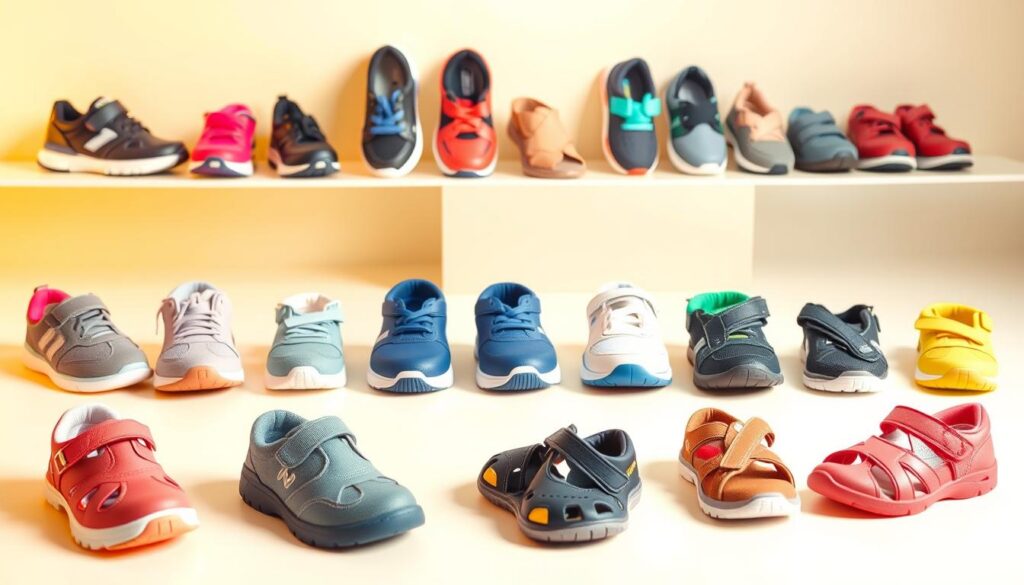
It’s important to understand the need for proper footwear for your child’s foot health. In this article, we’ll cover everything about shoes for flat feet kids. This includes understanding flat feet and the best shoes for support and comfort.
Introduction to Flat Feet in Children
Flat feet in children can worry parents, but the right shoes can help. You’ll learn about the best shoes for flat feet kids, with images and prices. This will help you choose the right shoes for your child.
Key Takeaways
- Proper footwear is essential for children with flat feet in children
- Kids’ shoes for flat feet can provide support and comfort
- Understanding flat feet is crucial for finding the right shoes
- The right shoes can make a significant difference in daily activities
- Comfort and support are key factors in choosing kids’ shoes for flat feet
Understanding Flat Feet in Children
As a parent, you want your child to be happy and healthy. Flat feet can affect their daily life and well-being. It happens when the arch of the foot collapses, making the whole sole touch the ground. Knowing the causes of flat feet in kids and the signs of flat feet in children is key.
The causes of flat feet in kids include genetics, obesity, and some medical conditions. Some kids are born with it, while others get it over time. Spotting the signs of flat feet in children early is important for treatment and support.
Common signs of flat feet in children include foot, ankle, or leg pain. They might also have trouble walking or running. Ignoring flat feet can make everyday activities hard, like playing sports or running with friends. Knowing the causes of flat feet in kids and the signs of flat feet in children helps you support your child.
- Pain or discomfort in the feet, ankles, or legs
- Difficulty walking or running
- Flat or low arches
Being aware of these signs and taking action can help your child manage flat feet. This way, they can stay healthy and active.
Why Proper Footwear Matters for Flat-Footed Children
As a parent, you want the best for your child, including their foot health. The right shoes are key for kids with flat feet. They help prevent pain and discomfort caused by unsupportive shoes.
Good shoes can ease this pain by spreading out pressure. They also help with balance and stability. This is vital for kids, as they’re still learning to move and might fall more easily.
When looking for shoes, consider these features:
- Good arch support
- A comfortable and cushioned insole
- A sturdy and supportive sole
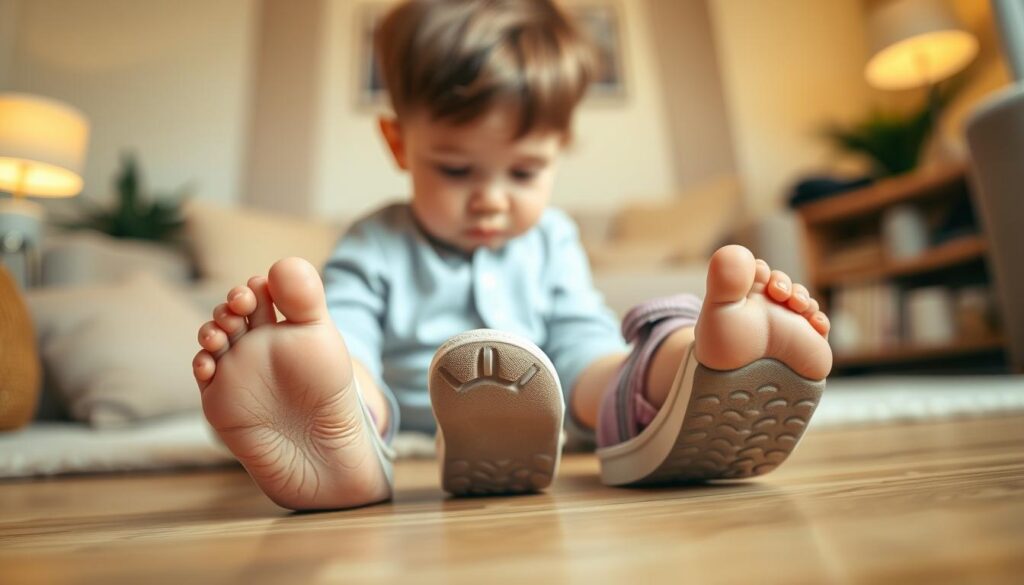
Choosing the right shoes keeps your child comfortable and active. It also protects their feet and ankles from long-term damage. Remember, the right shoes are essential for your child’s health and happiness.
Essential Features to Look for in Kids’ Flat Feet Shoes
When looking for shoes for your flat-footed child, there are key features to consider. You want shoes that help spread out pressure and ease stress on their feet and ankles. Arch support for flat feet kids is crucial for their comfort and movement.
It’s also important to choose shoes made from the best materials for kids’ shoes. Look for breathable and durable materials like leather or mesh. These keep your child’s feet cool and dry, preventing blisters and discomfort.

Key Considerations for Support and Comfort
- Look for shoes with sturdy arch support and a comfortable, cushioned insole.
- Consider shoes made from high-quality, breathable materials that will keep your child’s feet cool and dry.
- Choose shoes that offer flexibility and durability, as kids’ shoes need to withstand rough play and daily wear and tear.
By focusing on these essential features, you can find the right shoes for your child. They’ll get the support and comfort they need to stay active and happy.
10 Best Ideas of Shoes for Flat Feet Kids with Image and Prize
Finding the right shoes for kids with flat feet can be tough. You want them to be comfy, supported, and stylish. When looking for best athletic shoes for flat feet kids, many brands are available. Nike, Adidas, New Balance, and ASICS are some of the top choices.
We’ve made a list of the top shoes for kids with flat feet, including top school shoes for flat feet kids. Here are some great options:
- Nike Air Zoom Pegasus
- Adidas Superstar
- New Balance 574
- ASICS Gel-Kayano
These shoes have arch support, cushioning, and stability. They’re great for kids who love sports or active play. For daily wear, look for shoes that support the arch and fit well.
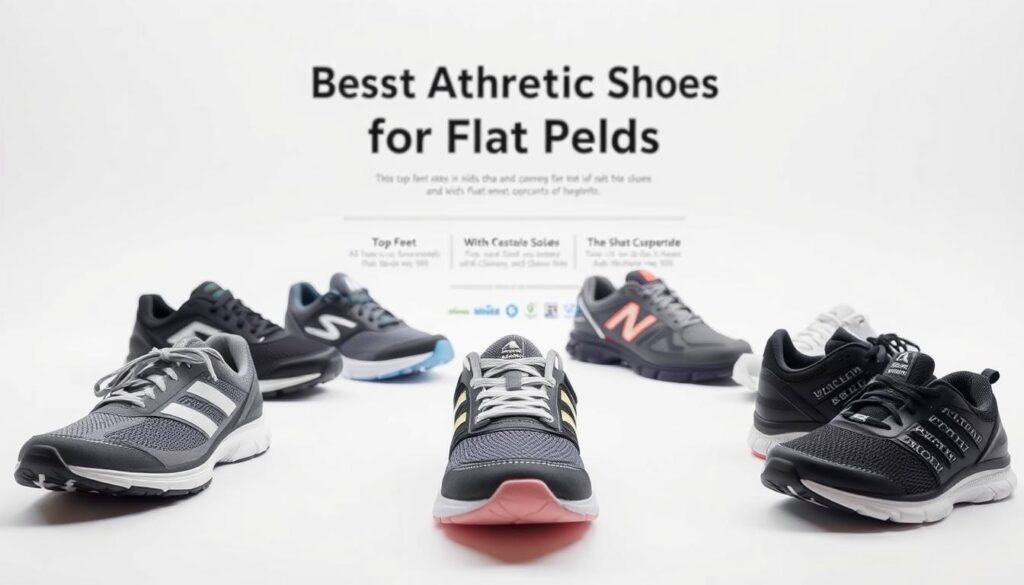
Athletic Shoes
Athletic shoes are perfect for kids with flat feet who enjoy sports. They should have arch support and cushioning to protect their feet.
School Shoes
School shoes are crucial for kids with flat feet. Choose ones with arch support and a comfy fit to ease pain and discomfort all day.
Casual Wear Options
For casual wear, pick shoes with arch support and a good fit. Sneakers and sandals are excellent choices. They offer comfort and support for kids with flat feet.
How to Measure Your Child’s Feet Correctly
To get the right fit, measuring your child’s feet is key. Have them stand on a flat surface with their weight balanced. Use a ruler or tape to measure their foot length and width. A foot measurement guide or shoe size chart can also guide you.
When learning how to measure kids’ feet, follow these steps:
- Stand your child on a flat surface with their weight evenly distributed on both feet.
- Use a ruler or measuring tape to measure the length and width of their feet.
- Use a foot measurement guide or a shoe size chart to help determine the correct size.
A foot measurement guide is a great tool for the right fit. By following these steps and using a guide, you can make sure your child’s shoes fit well. This gives them the support and comfort they need.

Remember, measuring your child’s feet correctly is crucial for the right shoes. By doing it right and using a foot measurement guide, you help keep their feet healthy and happy.
Breaking in New Shoes: Tips and Tricks
Breaking in new shoes can be tough, especially for kids with flat feet. You want your child’s shoes to be comfy and support their feet well. Start by wearing the shoes for short times, like an hour or two, and then wear them more.
This helps your child get used to the shoes and avoids discomfort or pain. Watch for comfort indicators like pain or discomfort. If your child keeps feeling pain, you might need to size up or try a different style.
Initial Wearing Period
When first wearing the shoes, keep an eye on how comfy they are. You can also try tips for comfortable shoes, like wearing the same socks or using shoe inserts for extra support.
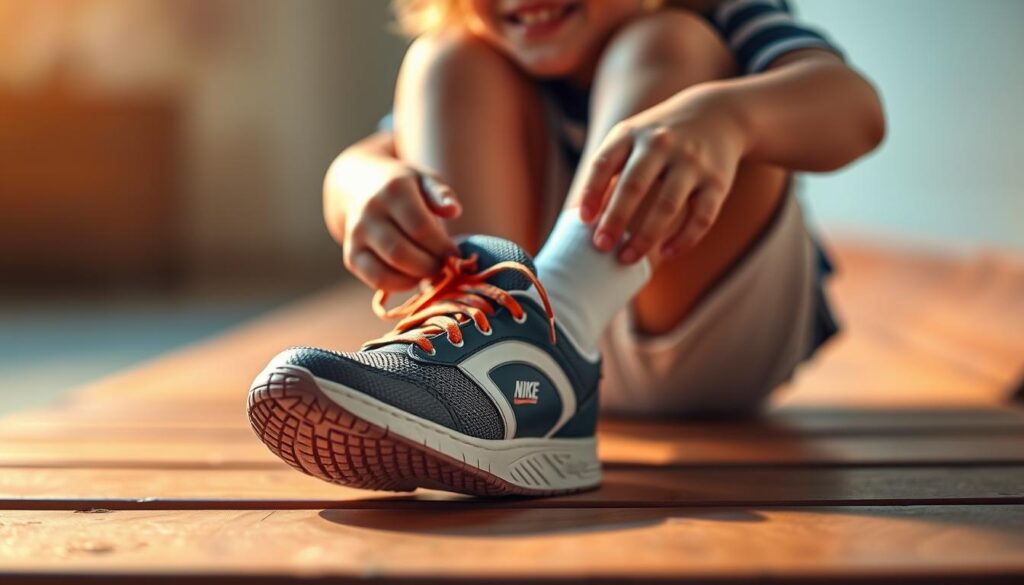
Comfort Indicators
Signs like pain or discomfort mean the shoes might need adjusting or replacing. Listen to your child and make changes to keep their shoes comfy and supportive.
When to Size Up
If your child keeps feeling pain, it’s time to size up or try a different style. Don’t be afraid to ask a shoe fitter or a healthcare professional for help with breaking in new shoes and finding the right fit.
Maintaining Your Child’s Supportive Footwear
To keep your child’s shoes in top shape, follow some easy shoe care tips. Cleaning and drying them regularly stops bacteria and fungi. This prevents bad smells and damage. Use a soft cloth and mild soap for cleaning, then air dry them.
It’s key to avoid sharing shoes or wearing them when wet. This can harm the shoes and shorten their life. Encourage your child to wear them only when dry and not to share with others. These steps help your child’s shoes last longer and stay comfortable.

- Store the shoes in a cool, dry place
- Avoid exposing the shoes to direct sunlight
- Use a shoe tree or stuff the shoes with paper to maintain their shape
By using these tips, you can keep your child’s shoes in good condition. This ensures they stay supportive and comfortable for their feet.
Common Mistakes to Avoid When Buying Kids’ Shoes
Buying shoes for your child can be tricky. It’s important to avoid mistakes that might cause discomfort or even harm their feet. Knowing what to look for can help you choose the right shoes for your child.
One big mistake is picking the wrong size. Shoes that are too tight or too loose can be uncomfortable. They might even affect your child’s posture and foot health. Another mistake is choosing shoes made from low-quality materials. These can be uncomfortable and might not last long.
Size Selection Errors
To avoid size mistakes, measure your child’s feet correctly. Try on shoes at the end of the day, when feet are biggest. Make sure there’s enough room for toes to wiggle.
Material Misconceptions
It’s important to choose shoes made from good materials. Look for breathable materials like leather or mesh. Avoid shoes with harsh chemicals or dyes.
Support Level Mistakes
Not considering the shoe’s support level can cause discomfort. Look for shoes with good arch support and comfortable cushioning. By avoiding these mistakes and following tips, you can help your child’s feet stay healthy.
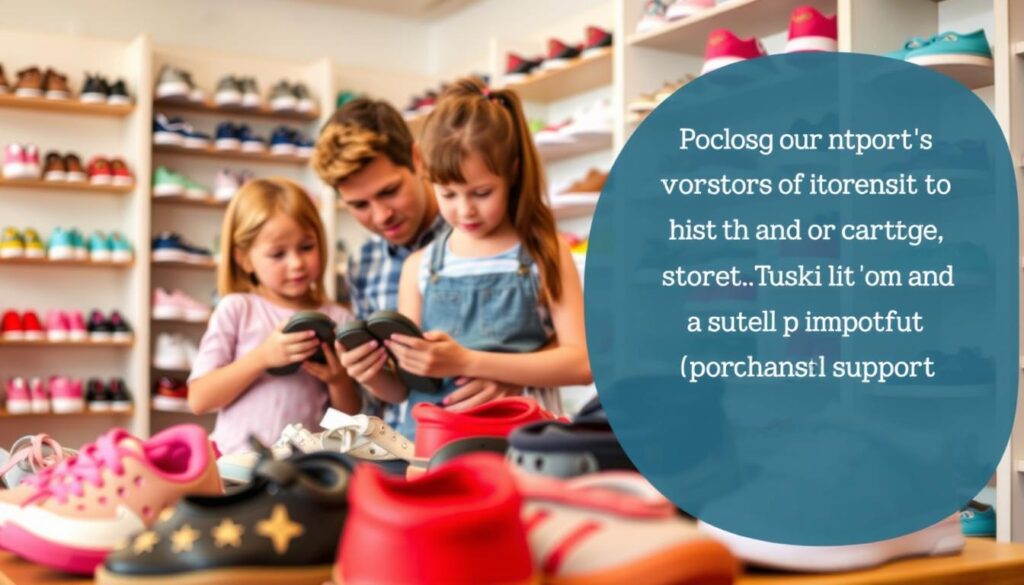
Being careful when choosing shoes can make your child happy and comfortable. Always put your child’s foot health first. Follow shoe buying tips to make the best choices for their needs.
| Common Mistake | Shoe Buying Tip |
|---|---|
| Size Selection Errors | Measure feet correctly, try on shoes at the end of the day |
| Material Misconceptions | Choose breathable materials, avoid harsh chemicals |
| Support Level Mistakes | Look for good arch support, comfortable cushioning system |
When to Replace Your Child’s Shoes
As a parent, knowing when to replace your child’s shoes is key. You should check their shoes often for wear and tear. Look for holes, tears, or soles that are too worn out. This helps prevent discomfort and foot problems.
Some signs it’s time for new shoes include:
- Soles that are worn down to less than 1/4 inch of thickness
- Shoes that are too tight or have become misshapen
- Visible signs of wear and tear, such as cracks or holes in the material
Also, watch for signs of growth. If the shoes are too tight or the toes touch the end, it’s time for new ones. These signs help you know when to replace shoes for your child’s comfort and support.
By watching for these signs and replacing shoes when needed, you can avoid discomfort and foot issues. This keeps your child happy and healthy.

Additional Support Methods Beyond Shoes
Looking for ways to help your child’s flat feet? There’s more than just shoes. Custom orthotics and insoles offer extra arch support and cushioning. They’re great for active times or when your child feels pain.
Physical therapy and exercises can also be beneficial. They strengthen the muscles in the feet and ankles. This can lessen pain and make daily activities easier. Using the right shoes along with these methods can give your child the support they need.
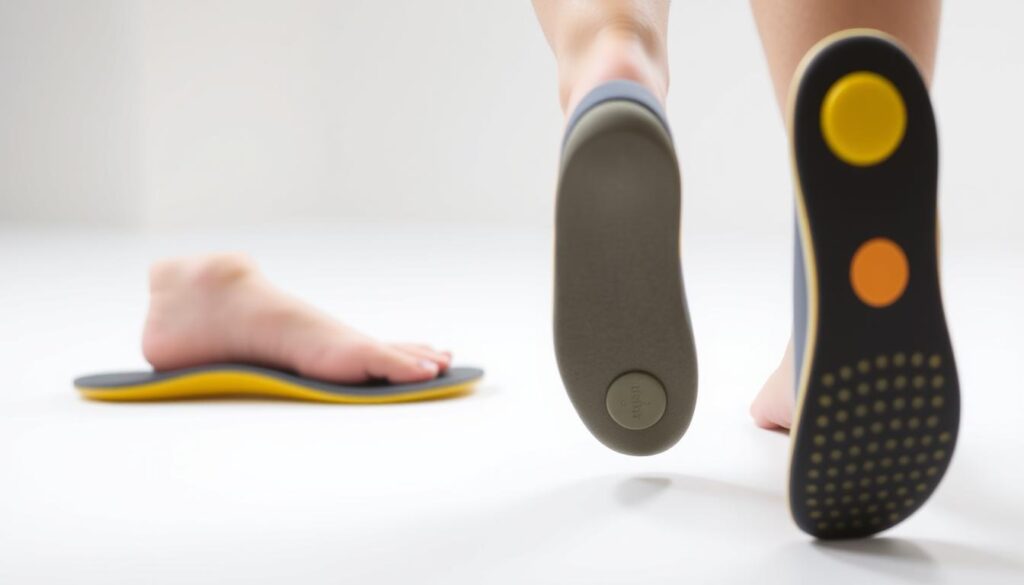
Orthotics and insoles have many benefits. They improve arch support, reduce foot pressure, and increase comfort. Trying these methods can help your child feel better and live a happier life.
Conclusion
Finding the right shoes for your child with flat feet is a journey. You’ve learned a lot from this guide. Now, you know how to pick shoes that are good for your child’s comfort and health.
Every child’s feet are different. What’s good for one might not be for another. Use the tips from this article to pick the best shoes for your child. Make sure they have the right arch support and are comfortable.
Keep an eye on your child’s shoe needs as they grow. Check how their shoes are wearing out and if they’re comfortable. This way, you can replace them when needed and keep their feet healthy.
Be open-minded and focused on your child’s health as you choose their shoes. With the right shoes and this guide, your child can be happy and confident. They can enjoy all the activities they love.
FAQ
What causes flat feet in kids?
Flat feet, or fallen arches, can come from genetics, being overweight, or certain health issues.
How can I tell if my child has flat feet?
Look for pain or discomfort in their feet, ankles, or legs. Also, if they struggle to walk or run.
Why is proper footwear important for flat-footed children?
The right shoes can ease pain and prevent more problems. They help spread out pressure and support the feet and ankles.
What features should I look for in shoes for my child’s flat feet?
Look for strong arch support, materials that breathe and last long, and flexibility for daily wear.
How do I measure my child’s feet correctly?
Have them stand on a flat surface with even weight. Measure length and width with a ruler or tape. Use a size chart to find the right fit.
How do I break in new shoes for my child with flat feet?
Start with short wear times and gradually increase. Watch for signs of discomfort. If it persists, consider a different size or style.
How can I maintain my child’s supportive footwear?
Clean and dry the shoes regularly to stop bacteria and fungus. Don’t share shoes or wear them when wet to avoid damage.
What common mistakes should I avoid when buying kids’ shoes?
Avoid picking the wrong size, choosing low-quality materials, and not checking the shoe’s support level.
When should I replace my child’s shoes?
Check for wear and tear like holes or excessive soles wear. Also, watch for signs of outgrowing, like tightness or toes touching the shoe end.
What other support methods can I use beyond shoes?
Orthotics and insoles can add arch support and cushioning. Physical therapy and exercises can strengthen foot and ankle muscles.
READ MORA
10 Best Running Shoes For Female Flat Feet With Image And Price
